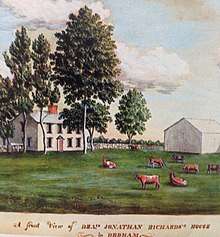Broad Oak (Dedham)
Broad Oak also known as Broad Oaks, was an estate in Dedham, Massachusetts owned by Edward Richards and his family, and then later Ebenezer Burgess and his descendants. Today the name lives on as part of the Broad Oak Farm which is located on part of the original estate.[1]

History
Though Dedham was intended to be a Utopian commune, and there was little disparity in wealth, Richards went by the title of "Gent" and, unlike others, aspired to a manor.[2] He received large tracts of land, second only to the minister, John Allin.[2] One such tract of land was originally owned by a Mr. Cook, who was probably from Watertown.[2] After Cook's death, the land was sold by his estate to Anthony Fisher in 1652.[3] The next year, Fisher sold it to Henry Phillips.[4] This land eventually became Broad Oak.
Richards purchased the property sometime between 1653 and 1670 and, while no record exists recording the transfer, it is suspected it was closer to 1670.[4] Early records of the town indicate that Richards was interested in building a "manor house" on his extensive land holdings.[5] The Broad Oak estate and house were located northwest of the Dedham village, on a bend in the Charles River, off West Street near the present day border of Needham.[6][4][1][lower-alpha 1]
Edward Richards left the property to his son, Nathaniel, and Nathaniel left it to his son, Edward.[8][9] It then passed down through generations of the Richards family, to Nathaniel, James, Ebenezer, and finally to Deacon Jonathan Richards. [8] Jonathan sold it to his friend and minister, Rev. Ebenezer Burgess of the Allin Congregational Church.[8][7][10] The land was surveyed in 1831 and a deed drawn up then, but it was not recorded until 1838.[6] It is presumed that Jonathan Richards, a widower, may have lived on the land for a time after he sold it to Burgess.[6] Burgess tore down the Richards home[11] and built a new mansion on the lot in 1839.[6][12] Burgess operated it as an "extensive cattle farm."[1]
When and horse and buggy were stolen from the estate in 1904, the Society in Dedham for Apprehending Horse Thieves attempted to capture the criminal.[13] As of 1942, some of the original Richards estate was still in the hands of Richards family. The Burgess family remained at Broad Oak at least until the 1940s when State Representative John K. Burgess lived there.[14][6][15]
Notes
References
- "An evening of cocktails by the river" (PDF). Dedham Historical Society News-Letter (May 2011): 1. Retrieved November 11, 2019.
- Morse 1861, p. 105.
- Richards 1942, p. 15.
- Richards 1942, p. 16.
- Richards 1942, p. 17.
- Richards 1942, p. 20.
- Morse 1861, p. 105-106.
- Richards 1942, p. 19.
- Morse 1861, p. 106.
- Slafter, Carlos (1905). A Record of Education: The Schools and Teachers of Dedham, Massachusetts, 1644-1904. Dedham Transcript Press. p. 83. Retrieved 19 November 2019.
- Richards 1942, p. 21.
- Hurd, Duane Hamilton (1884). History of Norfolk County, Massachusetts: With Biographical Sketches of Many of Its Pioneers and Prominent Men. J. W. Lewis & Company. p. 77. Retrieved 19 November 2019.
- "To catch horse thieves". The Boston Globe. July 19, 1904. p. 12. Retrieved November 20, 2019 – via Newspapers.com.

- Home Acres. 1918. p. 36. Retrieved 19 November 2019.
- "John K. Burgess of Dies at His Dedham Home". The Boston Globe. December 10, 1941. p. 17. Retrieved November 20, 2019.

Works cited
- Morse, Abner (1861). A Genealogical Register of the Descendants of Several Ancient Puritans, V. 3: The Richards Family. H.W. Dutton. Retrieved 18 November 2019.CS1 maint: ref=harv (link)
- Worthington, Erastus (1827). The history of Dedham: from the beginning of its settlement, in September 1635, to May 1827. Dutton and Wentworth. p. 29. Retrieved November 8, 2019.CS1 maint: ref=harv (link)
- Richards, Arthur Wescate (1942). Genealogy: the James Francis Richards branch of a Richards family of New England; that of Edward Richards, Dedham, Massachusetts, 1635-1684. Sarasota, Florida: Star Printing Company.CS1 maint: ref=harv (link)`